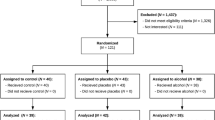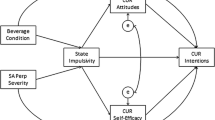Abstract
Behavioral interventions remain the preferred strategy for reducing HIV-related risk behavior among men who have sex with men (MSM), one of the populations most affected by HIV. To improve intervention efforts, research is needed to identify cognitive-motivational factors that may play a role in sexual risk behaviors among MSM. This study sought to replicate and extend previous work from a heterosexual population that identified a serial mediation effect of perceived intoxication and subjective sexual arousal in the relationship between alcohol consumption and determinants of sexual risk in a population of MSM. Exploratory moderated mediation analyses tested subjective sexual arousal as a moderator of the indirect effect of alcohol consumption on determinants of sexual risk via perceived intoxication. Participants (N = 117 MSM, ages 21–50) were randomly assigned to one of six experimental conditions based on two manipulations: beverage condition (alcohol, placebo, or control) and sexual arousal (low or high). Dependent measures were likelihood to engage in risky sex and condom negotiation skills. Results did not support the serial mediation effect but showed some support for the moderated mediation model in the prediction of behavioral skills. Implications for alcohol and arousal myopia theories of risky behavior and HIV prevention efforts are discussed.



Similar content being viewed by others
References
Johnson AS, Hall HI, Hu X, Lansky A, Holtgrave DR, Mermin J. Trends in diagnoses of HIV infection in the United States, 2002-2011. J Am Med Assoc. 2014;312(4):432–4.
Johnson WD, Diaz RM, Flanders WD, Goodman M, Hill AN, Holtgrave D et al. Behavioral interventions to reduce risk for sexual transmission of HIV among men who have sex with men. Cochrane Database Syst Rev. 2008(3). https://doi.org/10.1002/14651858.cd001230.pub2.
Kalichman SC, Weinhardt L. Negative affect and sexual risk behavior: comment on Crepaz and Marks (2001). Health Psychol. 2001;20(4):300–1. https://doi.org/10.1037/0278-6133.20.4.300.
Patterson DA, Wolf S, Hall M, Golder S. Beliefs and behaviors regarding substance use and HIV risk among men who have sex with men (MSM) in a mid-sized U.S. community. J HIV AIDS Soc Serv. 2009;8(2):188–201. https://doi.org/10.1080/15381500903025605.
Baliunas D, Rehm J, Irving H, Shuper P. Alcohol consumption and risk of incident human immunodeficiency virus infection: a meta-analysis. Int J Public Health. 2010;55(3):159–66. https://doi.org/10.1007/s00038-009-0095-x.
Shuper PA, Joharchi N, Irving H, Rehm J. Alcohol as a correlate of unprotected sexual behavior among people living with HIV/AIDS: review and meta-analysis. AIDS Behav. 2009;13(6):1021–36. https://doi.org/10.1007/s10461-009-9589-z.
Cooper ML. Toward a person × situation model of sexual risk-taking behaviors: Illuminating the conditional effects of traits across sexual situations and relationship contexts. J Pers Soc Psychol. 2010;98(2):319–41. https://doi.org/10.1037/a0017785.
Weinhardt LS, Carey MP. Does alcohol lead to sexual risk behavior? Findings from event-level research. Annu Rev Sex Res. 2000;11:125–57.
Berry MS, Johnson MW. Does being drunk or high cause HIV sexual risk behavior? A systematic review of drug administration studies. Pharmacol Biochem Behav. 2017. https://doi.org/10.1016/j.pbb.2017.08.009.
Rehm J, Shield KD, Joharchi N, Shuper PA. Alcohol consumption and the intention to engage in unprotected sex: Systematic review and meta-analysis of experimental studies. Addiction. 2012;107(1):51–9. https://doi.org/10.1111/j.1360-0443.2011.03621.x.
Maisto SA, Palfai T, Vanable PA, Heath J, Woolf-King SE. The effects of alcohol and sexual arousal on determinants of sexual risk in men who have sex with men. Arch Sex Behav. 2012;41(4):971–86. https://doi.org/10.1007/s10508-011-9846-x.
Loewenstein G. Out of control: visceral influences on behavior. Organ Behav Hum Decis Process. 1996;65(3):272–92. https://doi.org/10.1006/obhd.1996.0028.
Loewenstein G, Weber EU, Hsee CK, Welch N. Risk as feelings. Psychol Bull. 2001;127(2):267–86. https://doi.org/10.1037/0033-2909.127.2.267.
Blanton H, Gerrard M. Effect of sexual motivation on men’s risk perception for sexually transmitted disease: there must be 50 ways to justify a lover. Health Psychol. 1997;16(4):374–9. https://doi.org/10.1037/0278-6133.16.4.374.
Ariely D, Loewenstein G. The heat of the moment: the effect of sexual arousal on sexual decision making. J Behav Decis Mak. 2006;19(2):87–98. https://doi.org/10.1002/bdm.501.
Wray TB, Simons JS, Maisto SA. Effects of alcohol intoxication and autonomic arousal on delay discounting and risky sex in young adult heterosexual men. Addict Behav. 2015;42:9–13.
Steele CM, Josephs RA. Alcohol myopia: Its prized and dangerous effects. Am Psychol. 1990;45(8):921–33. https://doi.org/10.1037/0003-066X.45.8.921.
Ebel-Lam AP, MacDonald TK, Zanna MP, Fong GT. An experimental investigation of the interactive effects of alcohol and sexual arousal on intentions to have unprotected sex. Basic Appl Soc Psych. 2009;31(3):226–33. https://doi.org/10.1080/01973530903058383.
MacDonald TK, MacDonald G, Zanna MP, Fong G. Alcohol, sexual arousal, and intentions to use condoms in young men: applying alcohol myopia theory to risky sexual behavior. Health Psychol. 2000;19(3):290–8. https://doi.org/10.1037/0278-6133.19.3.290.
George WH, Davis KC, Norris J, Heiman JR, Stoner SA, Schacht RL, et al. Indirect effects of acute alcohol intoxication on sexual risk-taking: the roles of subjective and physiological sexual arousal. Arch Sex Behav. 2009;38(4):498–513. https://doi.org/10.1007/s10508-008-9346-9.
Prause N, Staley C, Finn P. The effects of acute ethanol consumption on sexual response and sexual risk-taking intent. Arch Sex Behav. 2011;40(2):373–84.
Davis KC, Hendershot CS, George WH, Norris J, Heiman JR. Alcohol’s effects on sexual decision making: an integration of alcohol myopia and individual differences. J Stud Alcohol Drugs. 2007;68(6):843–51.
Engle KB, Williams TK. Effect of an ounce of vodka on alcoholics’ desire for alcohol. Q J Stud Alcohol. 1972;33(4-A):1099-105.
Marlatt GA, Demming B, Reid JB. Loss of control drinking in alcoholics: an experimental analogue. J Abnorm Psychol. 1973;81(3):233–41. https://doi.org/10.1037/h0034532.
Wilson GT, Lawson DM. Expectancies, alcohol, and sexual arousal in male social drinkers. J Abnorm Psychol. 1976;85(6):587–94. https://doi.org/10.1037/0021-843X.85.6.587.
Wilson GT, Lawson DM. Expectancies, alcohol, and sexual arousal in women. J Abnorm Psychol. 1978;87(3):358–67. https://doi.org/10.1037/0021-843X.87.8.358.
Maisto SA, Carey MP, Carey KB, Gordon CM. The effects of alcohol and expectancies on risk perception and behavioral skills relevant to safer sex among heterosexual young adult women. J Stud Alcohol. 2002;63(4):476–85.
Maisto SA, Carey MP, Carey KB, Gordon CM, Schum JL. Effects of alcohol and expectancies on HIV-related risk perception and behavioral skills in heterosexual women. Exp Clin Psychopharmacol. 2004;12(4):288–97. https://doi.org/10.1037/1064-1297.12.4.288.
Davis KC, George WH, Norris J, Schacht RL, Stoner SA, Hendershot CS, et al. Effects of alcohol and blood alcohol concentration limb on sexual risk-taking intentions. J Stud Alcohol Drugs. 2009;70(4):499–507.
Peplau LA. Human sexuality: how do men and women differ? Curr Dir Psychol Sci. 2003;12(2):37–40. https://doi.org/10.1111/1467-8721.01221.
Chivers ML, Seto MC, Blanchard R. Gender and sexual orientation differences in sexual response to sexual activities versus gender of actors in sexual films. J Pers Soc Psychol. 2007;93(6):1108–21. https://doi.org/10.1037/0022-3514.93.6.1108.
Rupp HA, Wallen K. Sex differences in response to visual sexual stimuli: a review. Arch Sex Behav. 2008;37(2):206–18.
Rieger G, Savin-Williams RC. The eyes have it: sex and sexual orientation differences in pupil dilation patterns. PLoS ONE. 2012;7(8):e40256.
Neave N, Menaged M, Weightman DR. Sex differences in cognition: the role of testosterone and sexual orientation. Brain Cognit. 1999;41(3):245–62.
Rahman Q, Wilson GD. Large sexual-orientation-related differences in performance on mental rotation and judgement of line orientation tasks. Neuropsychology. 2003;17(1):25–31.
Rahman Q, Abrahams S, Wilson GD. Sexual-orientation-related differences in verbal fluency. Neuropsychology. 2003;17(2):240–6.
Collaer ML, Hines M. Human behavioral sex differences: a role for gonadal hormones during early development? Psychol Bull. 1995;118(1):55–107.
Caplan PJ, Caplan JB. Thinking critically about research on sex and gender. New York: HarperCollins College Publishers; 1994.
Rahman Q, Wilson GD, Abrahams S. Biosocial factors, sexual orientation and neurocognitive functioning. Psychoneuroendocrinology. 2004;29(7):867–81.
Maisto SA, Simons JS. Research on the effects of alcohol and sexual arousal on sexual risk in men who have sex with men: Implications for HIV prevention interventions. AIDS Behav. 2016;20(1):158–72. https://doi.org/10.1007/s10461-015-1220-x.
Edwards JR, Lambert LS. Methods for integrating moderation and mediation: a general analytical framework using moderated path analysis. Psychol Methods. 2007;12(1):1–22.
Cahalan D, Cissin I, Crossley H. American drinking practices. New Brunswick: Rutgers Center for Alcohol Studies; 1969.
Woolf-King SE, Maisto S, Carey M, Vanable P. Selection of film clips and development of a video for the investigation of sexual decision making among men who have sex with men. J Sex Res. 2010;47(6):589–97. https://doi.org/10.1080/00224490903216748.
Abbey A, Saenz C, Buck PO. The cumulative effects of acute alcohol consumption, individual differences and situational perceptions on sexual decision making. J Stud Alcohol. 2005;66(1):82–90.
Hayes AF. Introduction to mediation, moderation, and conditional process analysis: a regression-based approach. New York: Guilford Press; 2013.
Preacher KJ, Rucker DD, Hayes AF. Addressing moderated mediation hypotheses: theory, methods, and prescriptions. Multivariate Behav Res. 2007;42(1):185–227.
Hayes AF. An index and test of linear moderated mediation. Multivariate Behav Res. 2015;50(1):1–22. https://doi.org/10.1080/00273171.2014.962683.
Aiken LS, West SG, Reno RR. Multiple regression: testing and interpreting interactions. Thousand Oaks: Sage; 1991.
Sher KJ, Walitzer KS. Individual differences in the stress-response-dampening effect of alcohol: a dose-response study. J Abnorm Psychol. 1986;95(2):159–67. https://doi.org/10.1037/0021-843X.95.2.159.
Moberg CA, Curtin JJ. Alcohol selectively reduces anxiety but not fear: startle response during unpredictable versus predictable threat. J Abnorm Psychol. 2009;118(2):335–47. https://doi.org/10.1037/a0015636.
Ajzen I. The theory of planned behavior. Organ Behav Hum Decis Process. 1991;50(2):179–211.
Ajzen I, Fishbein M. Understanding attitudes and predicting social behaviour. Englewood Cliffs: Prentice-Hall; 1980.
Fishbein M, Ajzen I. Belief, attitude, intention and behavior: an introduction to theory and research. Reading: Addison-Wesley; 1975.
Dermen KH, Cooper ML. Sex-related alcohol expectancies among adolescents: I. Scale development. Psychol Addict Behav. 1994;8(3):152–60. https://doi.org/10.1037/0893-164X.8.3.152.
Cooper ML, O’Hara RE, Martins J. Does drinking improve the quality of sexual experience?: Sex-specific alcohol expectancies and subjective experience on drinking versus sober sexual occasions. AIDS Behav. 2016;20(Suppl 1):40–51. https://doi.org/10.1007/s10461-015-1136-5.
Gilmore AK, George WH, Nguyen HV, Heiman JR, Davis KC, Norris J. Influences of situational factors and alcohol expectancies on sexual desire and arousal among heavy-episodic drinking women: acute alcohol intoxication and condom availability. Arch Sex Behav. 2013;42(6):949–59. https://doi.org/10.1007/s10508-013-0109-x.
George WH, Stoner SA, Norris J, Lopez PA, Lehman GL. Alcohol expectancies and sexuality: a self-fulfilling prophecy analysis of dyadic perceptions and behavior. J Stud Alcohol. 2000;61(1):168–76. https://doi.org/10.15288/jsa.2000.61.168.
Alexander MG, Fisher TD. Truth and consequences: using the bogus pipeline to examine sex differences in self-reported sexuality. J Sex Res. 2003;40(1):27–35. https://doi.org/10.1080/00224490309552164.
Fisher TD. Sex of experimenter and social norm effects on reports of sexual behavior in young men and women. Arch Sex Behav. 2007;36(1):89–100. https://doi.org/10.1007/s10508-006-9094-7.
Cooper ML. Alcohol use and risky sexual behavior among college students and youth: evaluating the evidence. J Stud Alcohol. 2002;supplement, (14):101–17.
Hughes KYR, Anderson VN. What turns women on? Black and White women’s sexual arousal. Int J Sex Health. 2007;19(2):17–31. https://doi.org/10.1300/J514v19n02_02.
Funding
This study was funded by the National Institute on Alcohol Abuse and Alcoholism (R01 AA14480 and 2K05 AA16928).
Author information
Authors and Affiliations
Corresponding author
Ethics declarations
Conflict of interest
The authors declare that they have no conflict of interest.
Ethical Approval
All procedures performed in studies involving human participants were in accordance with the ethical standards of the institutional and/or national research committee and with the 1964 Helsinki declaration and its later amendments or comparable ethical standards.
Informed Consent
Informed consent was obtained from all individual participants included in the study.
Rights and permissions
About this article
Cite this article
Buckheit, K.A., Mitzel, L.D., Maisto, S.A. et al. Moderated Mediation of Perceived Intoxication and Sexual Arousal on Determinants of Sexual Risk Behavior in Men Who Have Sex with Men. AIDS Behav 23, 1460–1470 (2019). https://doi.org/10.1007/s10461-018-2343-7
Published:
Issue Date:
DOI: https://doi.org/10.1007/s10461-018-2343-7




